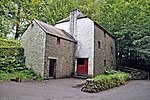Denbigh Cockpit

Denbigh Cockpit is a reconstructed building at St Fagans National Museum of History in Cardiff, the capital of Wales. The cockpit formerly stood in the yard of the Hawk and Buckle Inn at Vale Street, Denbigh, and is thought to date from the late seventeenth century. It is a Grade II listed building. Cockfighting became illegal in Britain in 1849, and the cockpit was used for other purposes over the years, such as a garage. In 1911 it was visited by members of the Royal Commission on the Ancient and Historical Monuments and Constructions in Wales and Monmouthshire, and was found to be "preserved with much care". It was in a poor state of repair by 1965, when a decision was made to move it to St Fagans. The cockpit was opened to the public at St Fagans in 1970.
Excerpt from the Wikipedia article Denbigh Cockpit (License: CC BY-SA 3.0, Authors, Images).Denbigh Cockpit
Valeways Millenium Heritage Trail, Cardiff St Fagans
Geographical coordinates (GPS) Address Website Nearby Places Show on map
Geographical coordinates (GPS)
| Latitude | Longitude |
|---|---|
| N 51.4876 ° | E -3.27736 ° |
Address
St Fagans National Museum of History
Valeways Millenium Heritage Trail
CF5 6XB Cardiff, St Fagans
Wales, United Kingdom
Open on Google Maps









